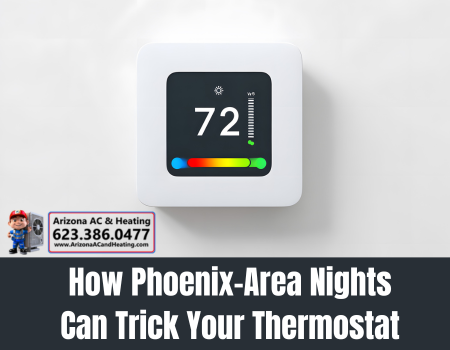 If you live in the Phoenix area, you already know the drill — blazing hot days followed by surprisingly cool nights. While that drop in temperature might seem like a relief, it can actually confuse your home’s thermostat and make your HVAC system work harder than it should. Understanding how Arizona’s diurnal temperature swings affect your indoor comfort can help you set your thermostat more efficiently and save on energy bills.
If you live in the Phoenix area, you already know the drill — blazing hot days followed by surprisingly cool nights. While that drop in temperature might seem like a relief, it can actually confuse your home’s thermostat and make your HVAC system work harder than it should. Understanding how Arizona’s diurnal temperature swings affect your indoor comfort can help you set your thermostat more efficiently and save on energy bills.
Phoenix’s desert climate is famous for its wide temperature gaps. It’s not unusual for daytime highs to hit 105°F and nighttime lows to drop into the 70s or even the 60s. That shift can make your HVAC system overcompensate if it isn’t programmed correctly, especially if your thermostat is located in an area that retains daytime heat.
Many homeowners keep their thermostats set to a fixed temperature, assuming it will regulate automatically. But in Arizona’s desert climate, that approach wastes energy. Your system doesn’t need to run at full power overnight when the outside air naturally cools down. Adjusting your settings to account for these temperature swings is one of the easiest ways to improve comfort and efficiency.
The Science Behind the Swing
In a desert climate, the dry air lacks humidity to retain heat, causing temperatures to fall rapidly after sunset. However, your home’s structure — especially if it’s made of stucco or concrete — holds onto that daytime heat longer. This means that even when it’s cool outside, the inside of your home may still feel warm, prompting your thermostat to keep running the AC unnecessarily.
This mismatch between indoor and outdoor temperatures can lead to inefficient cooling cycles and higher electricity use. The solution lies in adjusting your overnight cooling strategy in Arizona to match how your home absorbs and releases heat.
Smart Settings for Phoenix Nights
- Raise Your Temperature Before Bed
Set your thermostat to rise slightly — around 78°F to 80°F — during the night. Because outdoor air cools significantly, your system will run less while still maintaining comfort. If your home cools off too much by early morning, you can use your thermostat’s scheduling feature to bring it back down gradually before you wake up. - Use a Programmable or Smart Thermostat
A smart thermostat learns your habits and local temperature patterns, adjusting automatically as the outside temperature changes. Many models include sensors that track both indoor and outdoor conditions, allowing for real-time optimization. This helps prevent overcooling and unnecessary energy use while you sleep. - Leverage the Cool Night Air
Open windows strategically in the early morning hours when the outdoor temperature dips below your indoor temperature. This natural ventilation can lower your indoor temperature by several degrees without using electricity. Just be sure to close windows and blinds by mid-morning before the heat returns. - Check the Placement
If your thermostat is near a heat-retaining wall or receives direct sunlight during the day, it can give false readings at night. This causes your system to cool longer than necessary. Relocating your thermostat to a central, shaded area improves accuracy and efficiency. - Use Ceiling Fans Wisely
Ceiling fans don’t change the air temperature, but they help distribute cool air evenly. At night, set fans to rotate counterclockwise to create a cooling breeze. This allows you to raise the thermostat by a few degrees without feeling warmer.
Avoiding Common Mistakes
Many homeowners make the mistake of setting their thermostats too low at night, thinking it will help them sleep better. But dropping the temperature drastically can cause your HVAC system to cycle unnecessarily and may even lead to overcooling by dawn. This constant cycling wears down your unit and spikes energy consumption.
Another common oversight is ignoring humidity levels. Even though Arizona is dry, occasional monsoon moisture can impact how your body perceives temperature. A smart thermostat that monitors humidity helps maintain the ideal balance between comfort and efficiency.
The Role of Smart Home Integration
Smart thermostats paired with sensors and automated vents can adapt your home’s cooling strategy in real time. For example, if your living room retains more heat than your bedroom, your system can redirect airflow accordingly. Some systems even connect to local weather data to predict nighttime temperature drops and adjust settings preemptively.
This kind of thermostat night AZ climate optimization ensures your system isn’t working against nature. Instead, it works with the desert’s natural cooling rhythm.
Final Thoughts
Phoenix nights may feel cool and comfortable, but they can deceive your thermostat if you’re not careful. By fine-tuning your overnight cooling strategy, you can enjoy restful sleep, protect your HVAC system, and save money on energy bills.
The key is understanding how desert heat behaves — storing energy during the day and releasing it slowly after sunset. With the right thermostat settings, smart technology, and ventilation habits, you can take full advantage of the natural cooling cycle while keeping your home efficient and comfortable all year round.
